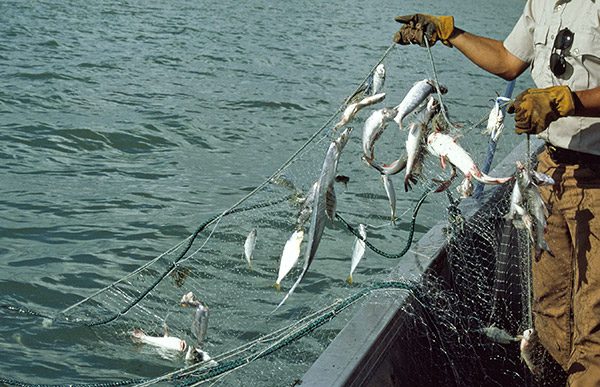Monday July 30, 2012
Gill net fishing for salmonids has been a tradition on the Columbia River since the 1850s. A gill net is a large section of net that is strung across the river using floats and weights so that it hangs vertically in the current. Fishes that swim through the net can become gilled, entangled, or wedged in the mesh. Because the nets are often large and span great distances, bycatch can be excessive. This tradition has been controversial over the years and in November Oregon voters will decide the future of the non-tribal commercial gill net fishery.
Those who oppose the Columbia River gill net fishery would like to see alternative methods used by the commercial fishing industry that are not as harmful to the thirteen stocks of salmonids that are listed as endangered or threatened under the Endangered Species Act. Columbia River fishing regulations only permit the take of hatchery origin (adipose fin clipped) salmonids, but gill nets can have high bycatch mortality and do not always allow for individuals to be selective in their take. An alternative may be to use seine nets, which are designed to corral the fish rather than entangle them. Once the net has closed around a school of fish, the fisherman can then sort the fish one-by-one to determine which can be kept and which need to be released back into the river. Although seines have been outlawed in Oregon and Washington since 1948 and 1934, respectively, in 2009 the Washington Department of Fish and Wildlife began a commercial selective gear project in the lower Columbia River that is designed to test the use of purse seines, beach seines and trap nets.
Those who oppose the ban on gill netting say that it would be devastating to the fishing industry and communities that rely heavily on the revenue provided by the industry. Since seining is still illegal, there is currently no comparable alternative capture method for the fishery to utilize. If gill nets are outlawed and the National Marine Fisheries Service were to allow for commercial fishing with the use of seine nets, then gill net fishers would require around $100,000 to outfit their boat to use the new method. So far, no compensation or funding has been provided to assist the commercial fishers with this transition. In an effort to reduce the amount of mortalities, some fishing vessels have tried using tangle or tooth nets. Designed with smaller mesh than gill nets, tangle nets wrap the fish by the mouth instead of the gills and are fished for shorter time periods, reducing stress and fatalities.
Despite efforts by the gill net fishery to reduce the unwanted fatalities, the industry remains highly scrutinized. It appears that there have been enough signatures collected to allow for a vote to outlaw the commercial gill net fishery come November. If restrictions are set on the fishery many salmonids would likely be saved, but many people would also become unemployed.

